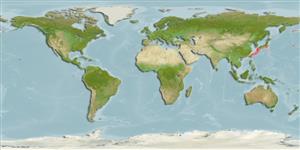Teleostei (teleosts) >
Gadiformes (Cods) >
Bathygadidae (Rattails)
Etymology: Bathygadus: Greek, bathys = deep + Latin, gadus = a fish; cod? (Ref. 45335).
Eponymy: Lieutenant-Commander LeRoy Mason Garrett (1857–1906) was an US Navy officer who had served on the fisheries steamer ‘Albatross’ (1883–1885) and later was master and commander of the vessel (1904–1906), from which the holotype was collected. [...] (Ref. 128868), visit book page.
More on authors: Gilbert & Hubbs.
Environment: milieu / climate zone / depth range / distribution range
Ecology
Marine; benthopelagic; depth range 361 - 544 m (Ref. 58018). Subtropical
Northwest Pacific: southern Japan and northeastern Taiwan.
Size / Weight / Age
Maturity: Lm ? range ? - ? cm
Max length : 51.0 cm TL male/unsexed; (Ref. 559)
Short description
Identification keys | Morphology | Morphometrics
Head moderately wide and comparatively firm, slightly longer that 1/2 length to vent. Snout low, not broad, slightly longer than or as long as orbit; width at frontal margin of orbit much narrower than twice preocular length. Orbit large. Mouth terminal and lateral, slightly oblique. Teeth minute, rather conical in shape, set in broad band on premaxillary and in narrow band on dentary. Scales small, cycloid, thin, and deciduous. Mandibular ramus with double scale rows, one of which consisting of large scales and the other smaller ones (Ref. 54421).
Body shape (shape guide): elongated.
Life cycle and mating behavior
Maturity | Reproduction | Spawning | Eggs | Fecundity | Larvae
Cohen, D.M., T. Inada, T. Iwamoto and N. Scialabba, 1990. FAO species catalogue. Vol. 10. Gadiform fishes of the world (Order Gadiformes). An annotated and illustrated catalogue of cods, hakes, grenadiers and other gadiform fishes known to date. FAO Fish. Synop. 125(10). Rome: FAO. 442 p. (Ref. 1371)
IUCN Red List Status (Ref. 130435: Version 2025-1)
Threat to humans
Harmless
Human uses
Tools
Special reports
Download XML
Internet sources
Estimates based on models
Preferred temperature (Ref.
123201): 8.7 - 13.8, mean 10.3 °C (based on 17 cells).
Phylogenetic diversity index (Ref.
82804): PD
50 = 0.5001 [Uniqueness, from 0.5 = low to 2.0 = high].
Bayesian length-weight: a=0.00372 (0.00141 - 0.00976), b=3.11 (2.88 - 3.34), in cm total length, based on LWR estimates for this (Sub)family-body shape (Ref.
93245).
Trophic level (Ref.
69278): 3.2 ±0.3 se; based on size and trophs of closest relatives
Fishing Vulnerability (Ref.
59153): Moderate vulnerability (40 of 100).
🛈
